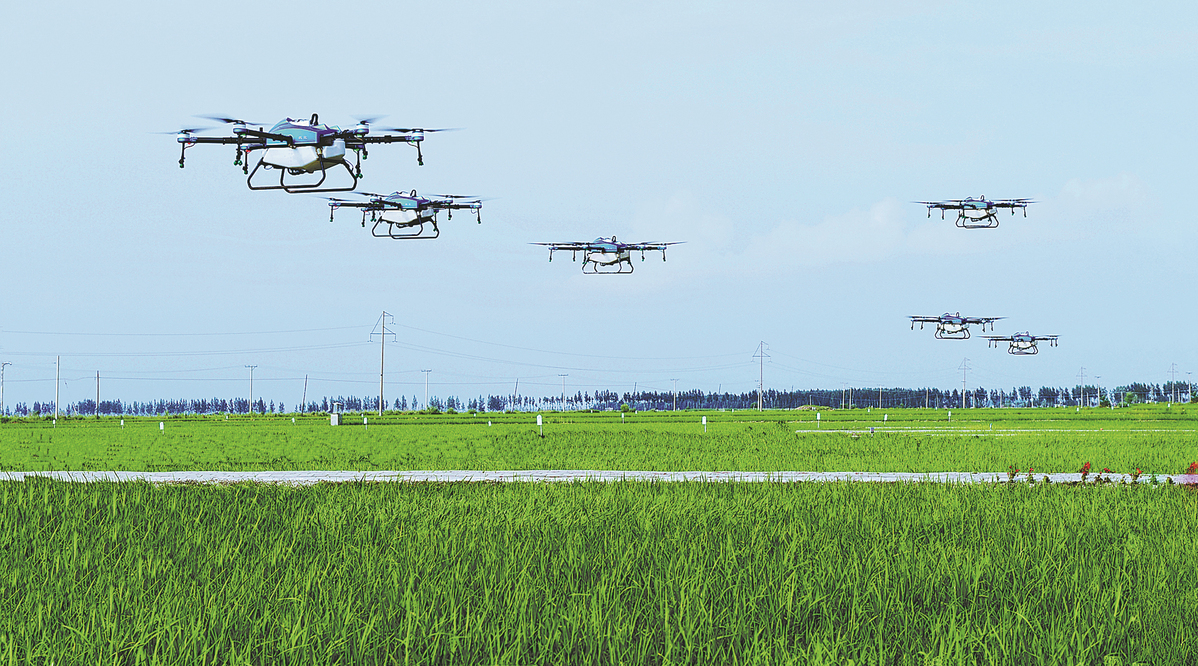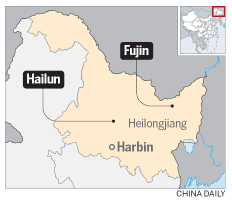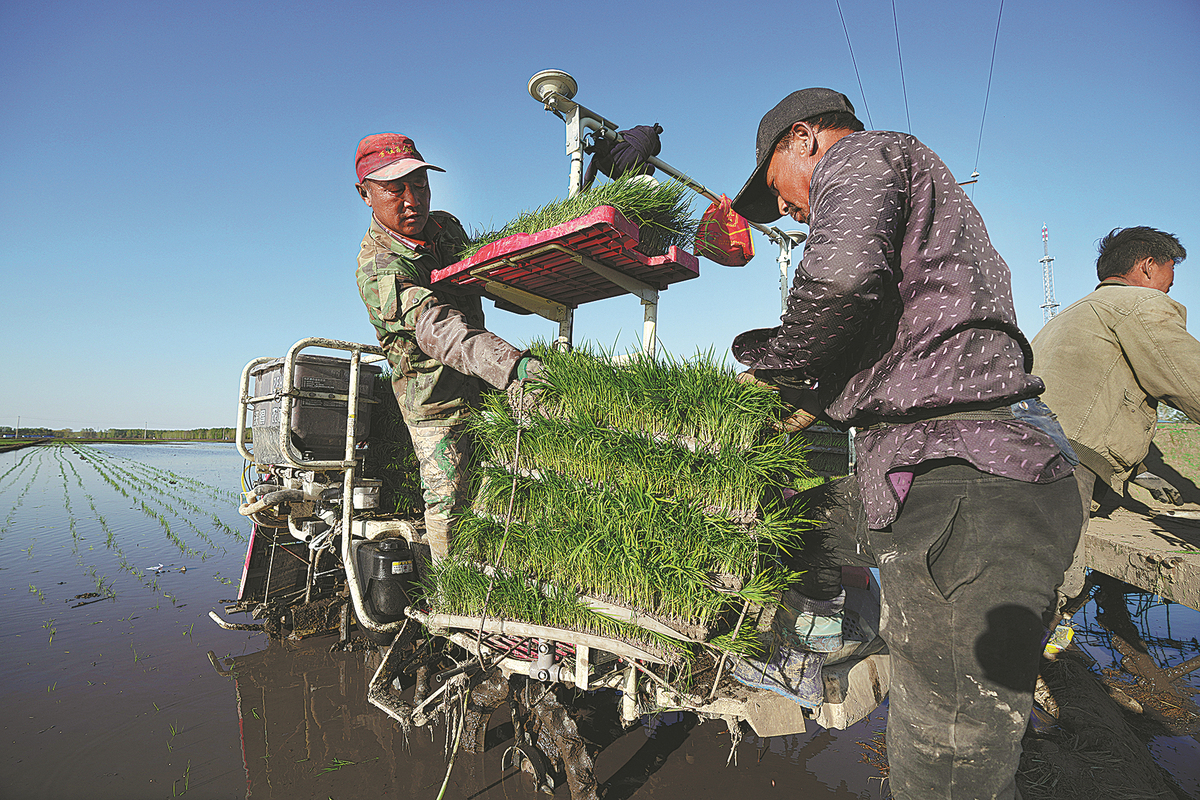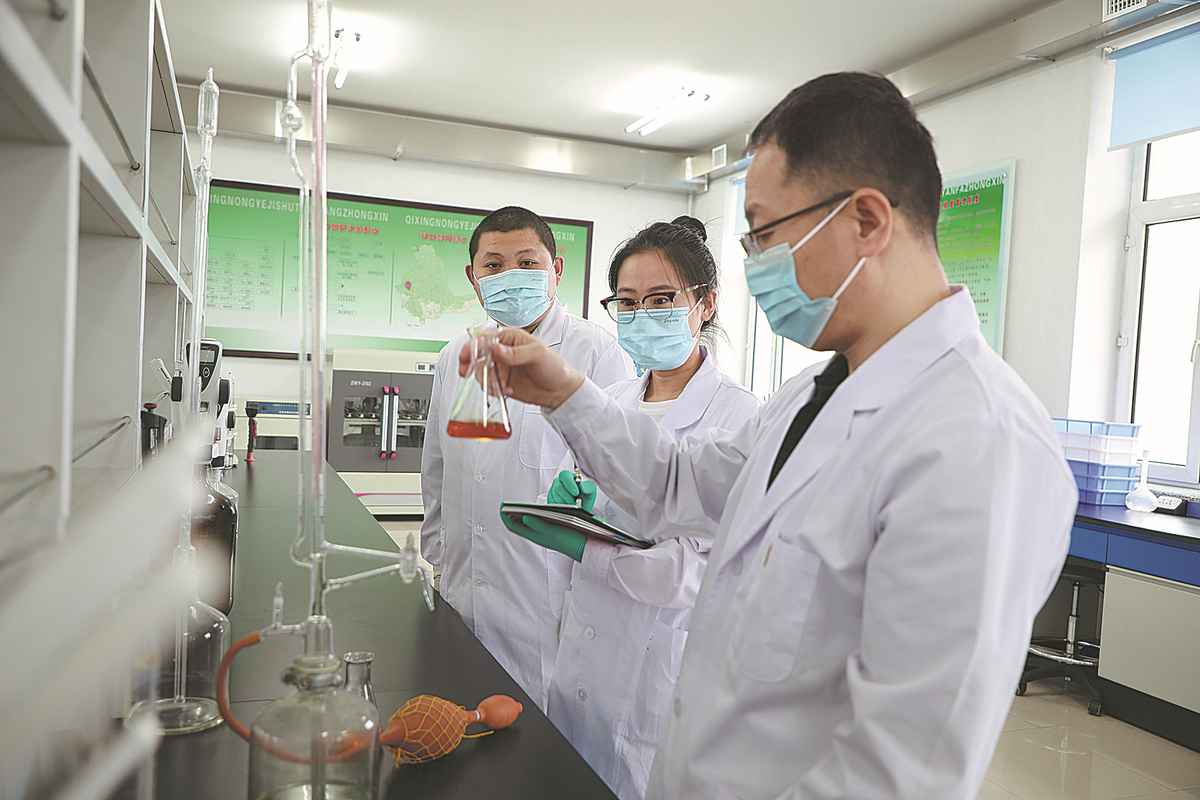
Agricultural drones fly above a field in Heilongjiang province. The level of agricultural mechanization in the province, a major grain producer in China, has reached 98 percent, according to the provincial Department of Agriculture and Rural Affairs. CHINA DAILY
As autumn approached, Zhang Jinghui began looking forward to another bumper harvest when he surveyed the rice seedlings growing steadily in his paddies.
The 60-year-old has worked the land at Qixing Farm in Fujin on the Sanjiang Plain-a major rice-growing area in Heilongjiang province-since, seeking a better life, he moved from the city of Suihua in Heilongjiang in 1995.
"Last year, the profit from my 23 hectares of rice was 160,000 yuan ($23,360)," he said. "With the help of modern agricultural technology and machinery, such as unmanned rice planters, I believe I will see high-quality rice and high yields this autumn."

CHINA DAILY
Qixing, a State-owned farm that is part of Jiansanjiang Co of the Beidahuang Group, has 71,333 hectares of arable land used for growing rice.
During a visit to Qixing in September 2018, President Xi Jinping stressed the importance of ensuring China's food security so that the country can always control its own food supply.
Agriculture is a fundamental sector, and China's modernization cannot be fully achieved without agricultural modernization, he said, adding that the vitalization of agriculture should rely on science and technology as well as talent.

Farmers transplant rice seedlings in Fujin, Heilongjiang province, in May, during the optimum planting period. WANG JIANWEI/XINHUA
In recent years, Qixing Farm has increased investment in science and technology, changing from traditional to modern agriculture, and now to intelligent agriculture.
Around 2000, Zhang was the first on the farm to switch the power source for the irrigation pump from diesel to electric power, which brought economic gains and lower labor costs.
He also pioneered the testing of new species, pesticides and technologies on his farm.
Five years ago, Zhang registered a trademark for his rice, which helped improve his family's annual income. Before he registered, he could only sell his rice to other merchants, who in turn packaged the rice with their own trademarks. Now, with his trademark, he can sell his rice after packaging it and get a higher price.
Li Dongguang, general manager of Qixing Co, said: "We have 48,300 agricultural machines, and the agricultural mechanization rate has reached 99 percent. So rice production has been fully mechanized."
"More than 40 percent of our arable land has been covered by the application of new practical technologies, such as using satellite navigation to assist rice transplanting," he said. "We also built a fully functional intelligent control platform for rice production to promote the whole process of intelligent rice planting."
A 5G, unmanned experimental rice field project began operation in the spring at Qixing Farm. A variety of new and advanced technologies are being tested on the 5.3-hectare field, including the use of automated tractors and rice planters, remote video monitoring and control, and real-time display of the data and movement of agricultural machinery.
The measures are expected to save 25 percent on the cost of labor and agricultural materials.
With a pristine ecology and one of the world's largest black soil zones, Heilongjiang leads the country in the amount of land devoted to planting rice, corn and soybeans, and also has the nation's highest annual yield.
In 2021, Heilongjiang saw its 18th consecutive bumper year, with a grain harvest of more than 78.6 million metric tons-3.26 million tons more than the previous year.
It also ranked first in the country in annual grain output for the 12th consecutive year.
"In 2022, the province has guaranteed a sown area of over 14.53 million hectares, and annual output is expected to reach over 75 million tons," said Wang Zhaoxian, director of the provincial Department of Agriculture and Rural Affairs.
"Over 4.57 million hectares has been used to plant soybeans, some 667,000 hectares more than last year. Total grain yield is expected to reach 8.5 million tons, an increase of 1.3 million tons from last year," Wang said.

Laboratory technicians from the Qixing branch of Beidahuang Group test soil samples for organic matter in April. XINHUA
According to the provincial government's work plan for soybean production in Heilongjiang for 2022, released at the beginning of the year, the planting of soybeans was to increase across the province this year, following a plan by the central government to rejuvenate the nation's soybean production.
Zhang Wenhai, 44, a farmer in the city of Hailun, Heilongjiang, which is a major production hub for high-quality soybeans, planted soybeans on two-thirds of his 1,340 hectares of land and corn on the remainder.
"The proportion of the two crops was the opposite last year, due to the companion planting of corn and soybeans, which can help protect the black soil and increase output," he said. "When I heard that the subsidy for planting soybeans would rise this year, I believed I could get higher profits." Companion planting refers to the alternate planting of corn and soybeans each year to protect the soil.
"Moreover, soybean prices have continued to rise in recent years. I can sell the crop for more than 6 yuan a kilogram, compared with 5.5 yuan last year," Zhang said. "With subsidies from the local government included, I earn about 5,000 yuan from a single hectare of soybeans."
According to the plan, soybean subsidies in the province will be 3,000 yuan per hectare higher than those for corn this year, though the precise amounts have not yet been released. Last year, soybean subsidies were 3,720 yuan per hectare, while those for corn were 1,020 yuan.
With higher profits from soybean farming, along with policies adopted by the local government to encourage soybean production, the amount of land in Hailun planted with soybeans this year is expected to rise to 180,820 hectares. That would be a year-on-year expansion of 16 percent, accounting for more than half of Hailun's farmland.
The city will take more measures to help farmers improve soybean productivity and quality, including promoting more superior species, building a pilot area for highly efficient production of high-quality soybeans and strengthening soil protection.
Heilongjiang has also seen remarkable effects after years of efforts to protect black soil. Black soil, according to the United Nations' Food and Agriculture Organization, refers to mineral soils with a black surface enriched with organic carbon that is at least 25 centimeters deep.
With its high density of organic matter, black soil is very suitable for growing crops. However, long-term cultivation and overuse of fertilizers have caused degeneration of the soil, threatening the local environment and grain production, said Yue Zhongming, an official on the Legislative Affairs Commission of the Standing Committee of the National People's Congress, after the Law on the Protection of Black Soil was passed in June.
Faced with the erosion of black soil due to intensive cultivation and the effects of wind and water, Heilongjiang has taken measures according to local conditions, including covering the soil with straw after harvest, increasing the amount of organic fertilizer and using crop rotation.
Since 2015, the province has established 20 pilot projects on the protection and utilization of black soil, covering an area of 348,400 hectares.
The average thickness of the topsoil of cultivated land increased from 19.8 cm in 2014 to 23.3 cm in 2019, according to the provincial Department of Agriculture and Rural Affairs.
According to the province's plan for protecting black soil, by 2030,9.86 million hectares of black soil in the province will be better protected and will see an annual grain output of 80 million tons.
Over the past decade, Heilongjiang has vigorously promoted its agricultural modernization.
At present, 6.09 million hectares of high-standard farmland that can withstand drought or flooding have been developed in the province.
By the end of 2021, 98 percent of operations during the cultivation and harvesting in the province was done by machines, according to the province's agriculture department.
Source: China Daily
Editor: Lyu Yun